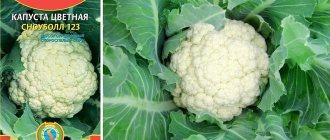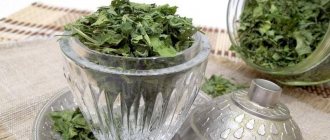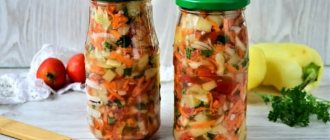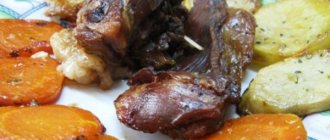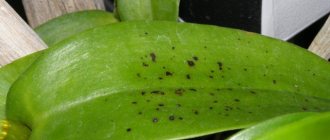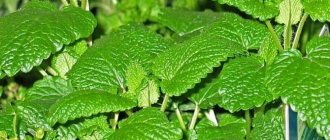Great for freezing, cauliflower is a member of the mustard family with a wonderful nutty flavor. There are many dishes made from cauliflower: salads, cold and hot appetizers, soups, vegetable stews or side dishes for meat and fish dishes. It is served raw, boiled, stewed, fried, steamed and baked.
How to choose the right cauliflower before freezing it? The snow-white inflorescences of cauliflower are protected from the sun by a dense layer of leaves. If you see gray spots on them, you know that these are “sunburn”, just cut them off. Choose dense heads of cabbage with inflorescences adjacent to each other, without black spots that indicate that the cabbage has begun to deteriorate. And the inflorescences separating from each other indicate that the head of cabbage is not young. The ideal size cabbage weighs 600-700 g. Larger heads of cabbage may be overripe and will take longer to cook.
Most often, for preparing dishes, cauliflower is disassembled into inflorescences (by the way, for freezing too), but you can stuff a whole head of cabbage or cut it into slices - prepare the so-called cauliflower steaks . When boiling cauliflower in water, add a little milk or cream to the pan to preserve the cabbage's snow-white color and give it a creamy taste.
Cauliflower goes well with lemon and orange, with butter and olive oil, with yogurt and tomatoes, with cheese sauces, almonds and other nuts, with curry and nutmeg.
Baked Cauliflower with Apple Curry is one of the best cauliflower dishes for all cauliflower fans, see the recipe here
Is it possible to freeze cauliflower for the winter in the freezer?
Cauliflower, like other vegetables, can be frozen for a delicious winter stew or any other recipe. It will take less time to prepare, since the vegetables are already washed, dried and chopped, which simplifies the cooking process. It’s very convenient to have frozen vegetables in the freezer, from which you can easily prepare any dish. You can add other vegetables to the cauliflower to make a mix. And if properly prepared, it will not lose its appearance and retain all its beneficial properties.
What you can cook: recipes
For a child: cauliflower soup
This is a very healthy and nutritious dish for a child. This soup can be prepared not only with meat, but also with vegetable broth.
We will need the following products:
- 50 grams of beef pulp;
- 30 grams of carrots;
- 5 grams of onion;
- 60 grams of cauliflower;
- A teaspoon of olive oil;
- 200 milliliters of water.
Another recipe: Freezing corn at home for the winter in grains and cobs: preserving vitamins and taste!
Place the meat in a saucepan with cold water and put it on the fire.
- After boiling, pour out the liquid and rinse the meat with boiled water. The second time, fill the pulp with clean water and cook at a low boil. During the cooking process it is necessary to remove scale.
- After an hour, remove the meat and add diced onions and carrots to the prepared broth. Cook the vegetables for ten minutes.
- Then add cauliflower. Cook the soup for another five minutes.
- Remove the cooked vegetables from the soup and blend together with the meat in a blender.
- Add the required amount of broth to the resulting puree, pour in a teaspoon of oil. The soup is ready.
What is the best way to freeze cauliflower: boiled or raw?
First you need to understand for what purpose the product will be frozen. If this is complementary food for a small child, then it is worth boiling it first. In the case of other cooking methods, for example, stew or batter, you can do without boiling. For recipes where the vegetable is fried in an egg mixture, you can freeze it in large inflorescences; if there is a soup in the future, then divide it into small ones.
Did you know? There are not only white cauliflower in the world, but also yellow, green and even purple. It has natural inflorescences and is no less useful. Sellers rarely put them on shelves, as many buyers are afraid to take them, thinking that they are painted.
Why is blanching necessary?
French cooks were probably the first to blanch food, since the term itself comes from the French word blanchir, that is, to bleach, scald with boiling water. Such processing is done for various purposes. For example, the skin of a blanched tomato can be easily removed. And blanched kohlrabi takes on an amazing color and can be frozen without losing its nutritional properties. Blanching whitens bones and meat, removes the specific smell of foods or their excess bitterness, and so on. Blanching is the easiest way to peel peanuts and almonds.
Do I need to blanch and wash cauliflower to freeze?
It is necessary to wash the cauliflower before freezing in order to get rid of insects and dirt. When buying at the market, you cannot know how many people took it with their hands and in which boxes it was lying. After cleaning and washing the vegetable, it is advisable to immerse it in boiling water for a couple of minutes with the addition of lemon juice and acid to preserve the color and taste.
How to blanch food correctly
Treatment with high temperatures during blanching can occur in several ways:
- Briefly cook in boiling water or immerse in boiling water.
- Hot steam treatment.
How to blanch food in boiling water
With this processing method, the ratio of water to vegetables should be 4:1.
- Prepare the vegetables. To do this, wash them, peel them if necessary and cut them into pieces of the desired size.
- Boil the water. Place the vegetables in a colander or a special mesh for blanching.
- Place the food in boiling water. Wait for the water to boil again and note the time.
- Blanch the vegetables for as many minutes as directed in the recipe.
- Remove food from boiling water and immediately plunge into cold water, otherwise hot vegetables will continue to “cook.” You can place them under running water.
For some vegetables, simply scalding with boiling water is enough. So, cut the onion that you are going to use for the salad and pour over boiled water. This will preserve its beneficial properties, but at the same time remove the bitterness.
How to steam blanch foods
Steam blanching can be carried out either in a regular saucepan or in a steam or multicooker. The main thing is that there is a special grill with holes where the prepared products are laid out. This process is longer in time compared to treatment with boiling water.
- Pour water into the pan. The lowered grate should not reach the water. Boil it.
- Place the prepared vegetables on the grill in one layer - this way they will be processed more evenly.
- Lower the rack into the pan and cover with a lid.
- After the time specified in the recipe, remove it and, as in the previous method, place it in cold water.
Steam blanching is a more gentle processing method, because... with it, the amount of useful substances in the product does not decrease as much as when boiling.
How to properly freeze cauliflower
To ensure that the product retains its original appearance and taste, follow several rules:
- Take only juicy and fresh cabbage, without spots or other errors.
- Carefully wash and peel the vegetable.
- Disassemble into small inflorescences, after cutting off the green leaves.
- Bring water to a boil in a large saucepan and add salt (2 teaspoons of salt per 1 liter of water). And boil for 3 minutes.
- Immediately cool in cold water (you can even use ice cubes) for 5 minutes and dry by transferring to a board, towel or other dry and clean surface.
- Distribute into the required portions and place in special containers for freezing or bags, releasing the air from inside.
- Place containers or bags in the freezer.
- It is not recommended to re-freeze a defrosted product, since it has already succumbed to thermal effects..
Video: Freezing cauliflower for the winter
Quick freezing without blanching
You can freeze the vegetable without cooking, by first soaking it in salted cold water for 10–15 minutes, then rinsing it and doing the same steps as described above.
Important! If you have kidney problems, you should avoid this product. It contains a large amount of purines, which are converted into uric acid and lead to the formation of crystalline deposits in the joints.
In bags or barrels
To better preserve the product, it is necessary to release air to avoid excess ice in the freezer compartment and inside the bag. Kegs are considered more practical, since most of them already have vacuum lids.
Boil in salted water
For the first feeding of a baby or for adult children and even the whole family, you can pre-boil it in salted water. It becomes half-cooked and soft, which makes further cooking easier. For a homogeneous puree for babies, this vegetable is more suitable.
In most cases, uncooked cabbage will darken, turn yellow, or turn blue in the freezer. A pre-boiled vegetable will cook in a dish faster, so you need to add it last to avoid overcooking.
Why blanch food?
- Thanks to blanching, products retain their rich color and taste, remain firm and elastic. At the same time, such processing puts a “barrier” to raw food and allows you not to be afraid of bacteria.
- Blanching relieves some vegetables of bitterness (for example, endive, kale), unpleasant odor or overly pungent taste. For example, blanching makes onions much more delicate.
- Blanched potatoes, from which we are going to make chips, will absorb less fat.
- The use of this culinary technology ensures that fragile leafy vegetables (spinach, kale, sorrel) do not fall apart during cooking.
- Thanks to blanching, hard vegetables and fruits do not lose their shape or become soft.
- By processing rice in this way, we rid it of excess starch.
- Blanched cabbage makes it easier to separate the leaves.
- Thanks to this method, you can easily remove the skin or rind from the fruit. It is enough to pour boiling water over them for a few seconds to quickly peel, for example, a tomato, peach or nectarine.
- It is important to note that this method of processing food practically does not deprive it of elements and vitamins: we lose only a small amount of vitamin C and protein.
Shelf life of frozen cauliflower
Frozen foods, as a rule, are stored in the freezer longer than fresh ones , but still have their own expiration dates. It is advisable to try to prepare the remaining food in the freezer over the winter. Most housewives have even little supplies, since the volume of the freezer is not large and no matter how many vegetables are prepared, there are always not enough of them, especially if there are small children in the house.
Important! Frozen cauliflower will keep for 6 to 9 months.
Blanching vegetables: subtleties of the process
During blanching, the product is either simply doused with boiling water, or immersed in boiling water for several minutes, or kept in a closed container for the same few minutes, exposed to hot steam. The most important thing is not to overcook the product and not turn it into boiled. If you add a little baking soda or salt to boiling water in advance, the color of green vegetables will turn out simply emerald!
Blanched vegetables should be cooled as quickly as possible. Often, for cooling, they prepare not just cold water into which vegetables can be dipped after cooking, but water with ice. There should be a lot of it so that the vegetables do not heat the water, otherwise nothing will work.
How to defrost cauliflower
For complementary feeding, the baby should be placed in a double boiler without preliminary defrosting and set to the required mode. It is very easy and simple to make various purees in this way by adding not only cabbage, but also other vegetables. You can also defrost in the microwave for 30 seconds in a special heating container.
If you are worried that it will lose all its beneficial properties or you are against such ovens, you can leave it to defrost at room temperature, but it will take more time. Choose any method convenient for you based on the availability of free time.
Culinary secrets
A novice housewife planning to freeze cauliflower at home has many questions, some of which can puzzle even an experienced cook. We will try to give answers to them.
Which vegetables to choose for freezing?
Cauliflower can vary in color and shape. Snow-white, cream and greenish inflorescences are equally useful and store equally well. Buy whichever you like best. The freshness of the heads of cabbage matters. It is determined by the condition of the foliage. Vegetables spoiled by fungus are also not suitable for freezing: brown spots on the inflorescences indicate its presence.
Can cauliflower heads be frozen whole?
Can. But before use, they will need to be allowed to thaw at room temperature or in the main chamber of the refrigerator, otherwise they will lose some of their beneficial properties. Having saved time when preparing vegetables for the winter, you will spend it when you get ready to prepare any food from it.
What size should frozen florets be?
Inflorescences about 3 cm in size are considered ideal. They can be larger or smaller in size, but it is desirable that their size be approximately the same. Substandard pieces (too small, broken) can be frozen for soup, especially if it has a creamy consistency.
Do I need to boil cabbage before freezing?
Typically, the inflorescences are blanched for 3 minutes in slightly salted or acidified water, then cooled sharply by transferring them to ice water. Then, even after freezing, they retain a beautiful color and remain crispy. However, you can freeze the vegetable without boiling it. Just be prepared for the buds to become somewhat limp and a little less appetizing. But cabbage that is not boiled before freezing will retain more vitamins. It is often prepared this way to later be used for baby food.
Is it enough to wash the cabbage or do I need to do something else?
Preparing cauliflower before freezing involves more than just washing and cutting into florets. She must be allowed to dry. If there is a suspicion that bugs have settled in the inflorescences, they are also soaked in a saline solution. It is prepared from a tablespoon of salt dissolved in a liter of water.
Do bags and containers need to be sterilized?
There is no need for sterilization, but both bags and containers must be clean and dry. Bags must be bled of excess air before closing, sealing or tying.
What size containers are best to use?
It all depends on the size of the family. If it is large, it is advisable to freeze cabbage in portions of 400-500 g. Packing 200 g is also considered convenient, since this is often the amount of vegetable indicated in popular recipes. You can put the cauliflower into bags by eye, but we recommend using a kitchen scale.
Can cauliflower be frozen along with other vegetables?
Cauliflower is often frozen along with broccoli using a 1:1 ratio. However, it can also be prepared with other vegetables that require similar storage conditions. For example, a popular European mixture contains cauliflower, broccoli, green beans and carrots.
How long can frozen cauliflower be stored?
The question is important, and more than one experienced housewife has been burned by it. The shelf life of cauliflower depends on the capacity of your freezer:
- at a temperature of -6°C – 15-20 days;
- at a temperature of -12°C – 6 months;
- at a temperature of -18°C – 12 months.
In order not to expire the product, indicate the freezing date on the bags with a marker or attach notes to them with the relevant information.
We think now you have a good idea of how to freeze cauliflower for long-term storage, it’s time to move on to the recipes.
What can you make from frozen cauliflower?
A large number of recipes for delicious and simple dishes can be prepared from frozen cabbage. Both for the child and for the family as a whole. For example, vegetable stew, baby puree, any dish - you'll lick your fingers! You can boil it and give it to your child in pieces or grind it into a soft puree , you can also add zucchini, broccoli or carrots if the child is not allergic to these vegetables.
By making an egg mixture with flour, you will get a simple, but at the same time delicious battered dish. You can simmer in a frying pan, bake in the oven, cook with cheese sauce, fry in breadcrumbs, make cutlets or casserole.
Did you know? The largest inflorescence weighs 27 kg. World record holder at 1.8 m in length was raised by Peter Glazebrook
.
So, by following simple but important rules, you can easily freeze cauliflower for the winter, preserving both its beneficial qualities and appearance.
Blanching time for some vegetables
Blanch diced zucchini, small stalks of asparagus, chopped carrots, green peas, and any greens for two minutes.
Three minutes will be needed to blanch medium-sized asparagus stalks, broccoli florets, small heads of Brussels sprouts, coarsely chopped cabbage and Chinese cabbage, cauliflower florets, celery, whole kohlrabi, halves of sweet pepper.
Blanch large stalks of asparagus and large heads of Brussels sprouts, eggplants, whole small carrots, and medium-sized whole mushrooms for about five minutes.
By experimenting in the kitchen, you can quickly determine by experience how long it takes to blanch which vegetables. This means that your dishes will not only acquire new shades of taste, but will also look like real works of art.
